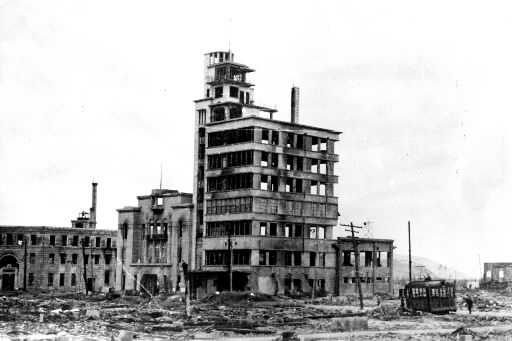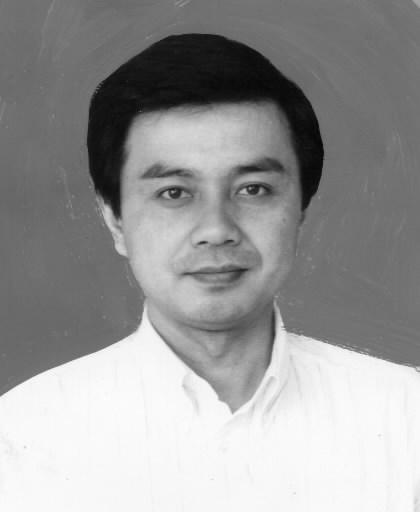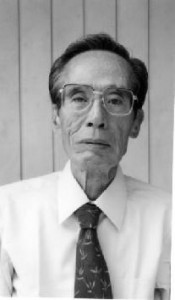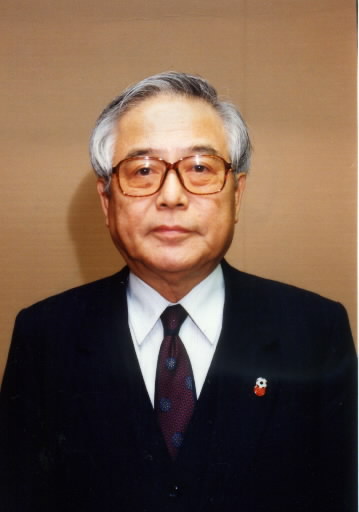History of Hiroshima: 1945-1995 (Part 30, Article 1)
Mar. 21, 2013
The news coverage of the Chugoku Shimbun (Part 1)
by Special reporting team for the 50th anniversary of the A-bombing
Note: This article was originally published in 1995.
The past 50 years have been dominated by the pessimistic view that “peace comes only after a war.” Fortunately, there have been no wars on a global scale during that time. Perhaps this is because the experiences of Hiroshima and Nagasaki etched the brutality of nuclear weapons in people’s memories, and the “balance of terror” has stopped humankind on the brink of using those weapons. The duty of Hiroshima and Nagasaki is to continue to tell the world of the destruction that resulted from the A-bombings. If they can continue to tell their stories in a fresh way with renewed vigor, their experiences will remain vivid, and a new tragedy can be prevented. The Chugoku Shimbun’s coverage of the A-bombing over the past 50 years has been part of that effort. To conclude this series, “History of Hiroshima: 1945-1995,” we look back at what the newspaper has conveyed over the past 50 years.
◆From the A-bombing through the 1950s
The Chugoku Shimbun lost more than 100 employees in the atomic bombing, and its offices were burned out. The paper asked the Osaka office of the Asahi Shimbun, the western headquarters of the Mainichi Shimbun and the Shimane Shimbun (now the Sanin Chuo Shimpo) to print its paper for it under the terms of a mutual assistance agreement in the newspaper industry, and from the day of the bombing every effort was made to continue its news coverage. The first papers printed by other newspaper companies were distributed on August 9, and until Japan’s defeat on August 15 the paper described the cruelty of the “new” and “special” bomb that had been dropped on the city. It also attempted to boost fighting spirit in various ways such as by noting that “injuries can be kept to a minimum by using bomb shelters equipped with a hatch.”
The Chugoku Shimbun resumed printing its own paper with the edition of September 3, after Japan’s defeat. From September 11 through 13 the paper ran a three-part series titled “Anatomy of the Atomic Bomb” featuring discussions with Masao Tsuzuki, a professor in the Faculty of Medicine at the University of Tokyo who had come to Hiroshima to conduct a survey after the bombing. These were the first articles in the Chugoku Shimbun to provide details on the power of the A-bomb and the effects of radiation. The paper consisted of only the front and back of one sheet, and one month after the bombing its coverage had begun to give a sense of the tremendous scale of the destruction.
On September 14 the General Headquarters of the Allied Occupation Forces (GHQ) began censoring articles distributed by the Domei News Agency, and on the 19th GHQ issued a press code. The Asahi Shimbun had run an article the day before stating, “It cannot be denied that the use of the atomic bomb and the attack on the hospital ship were violations of international law.” The paper was punished by being ordered to cease publication for 48 hours.
As a result of damage from the Makurazaki Typhoon, on September 17 the Chugoku Shimbun once again became unable to put out a paper, and it again sought the assistance of the Osaka office of the Asahi Shimbun and the western headquarters of the Mainichi Shimbun. The Chugoku Shimbun resumed printing its own paper with the November 5 edition.
Starting on November 10, the paper ran a six-part series entitled “Neighborhood Associations Undergo Renaissance,” offering encouragement to the people of Hiroshima, whose city had suffered catastrophic damage. If the five pillars of the Chugoku Shimbun’s A-bomb coverage are seen as destruction, reconstruction, commemoration, inheritance and peace, then “Anatomy of the Atomic Bomb” came under destruction, while the series on neighborhood associations represented coverage of reconstruction.
▽“City of peace” emphasized
It is difficult to say exactly to what extent coverage of the A-bombing was affected by the press code, but even after it came into effect the pages of the Chugoku Shimbun carried many articles related to the A-bombing. In fact, it may be more accurate to say that the end of the war freed the paper from the yoke of the military and it reveled in its first taste of freedom and democracy.
From 1946 until around 1949, “peace” and “no more Hiroshimas” often appeared in the Chugoku Shimbun, and the paper emphasized the rebuilding of Hiroshima, the first victim of an atomic bombing, as a “global city” and a “city of peace.” Publishing a paper based on “peace and democracy” was also in line with the wishes of the Occupation forces.
On the other hand, the horror of the harmful effects of radiation that the atomic bomb survivors suffered from did not get extensive coverage at that time. One reason was that Japanese people as a whole were impoverished and in poor health, so it was felt that the A-bomb survivors were not unique. Another reason was GHQ’s feeling that coverage of the horrors of the atomic bombing was “anti-Occupation,” and reporters themselves exercised self-restraint. One of the major transgressions of the press code was that it prevented the news media from looking at the horrors of the atomic bombing.
▽Shock of the Korean War
In this context, the start of the Korean War in June 1950 led not only Japan’s newspapers but also the nation’s history to once again take a wrong turn. At the order of GHQ, Hiroshima’s Peace Festival, which was sponsored by the city, was cancelled that year, and a “red purge” swept through various fields, including the news media. There was pressure on the Chugoku Shimbun’s “peace coverage,” which until then had been carried out relatively freely. The paper’s coverage of the atomic bombing that year focused primarily on commemoration and reconstruction. Through the following year its coverage of the peace movement was half-hearted, consisting only of a 10-part series entitled “Ten Views of the Atomic Bombing: A Follow-up.”
In 1952 the Treaty of Peace with Japan, which had been signed the year before, came into effect, and the nation regained its independence. In 1953 a truce was achieved in the Korean War. The Chugoku Shimbun once again enjoyed an atmosphere of freedom. But the harmful effects of the A-bombing on the survivors were not a major issue in the pages of the paper. Only two series, one on the “Hiroshima maidens” and another on “A-bomb orphans,” attracted attention. Although the A-bomb survivors continued to be regarded as unfortunate victims deserving of sympathy, the newspaper went no further than the notion of sympathy in its coverage of the harmful effects of the bombing.
▽Pursuing the government’s responsibility
The situation changed greatly with the hydrogen bomb tests on Bikini Atoll in 1954. The fishing boat Lucky Dragon No. 5 out of the port of Yaizu in Shizuoka Prefecture was covered in so-called “ashes of death,” and a large-scale popular movement to “ban the bomb,” unlike any that had ever been experienced before, spread rapidly. The atomic bomb survivors of Hiroshima and Nagasaki became the focus of the movement, and in 1956 the Japan Confederation of A- and H-bomb Sufferers Organizations was formed. The A-bomb survivors, who until then had been regarded merely as objects of sympathy and pity, stood up and, in a change of stance, held the state responsible for the war.
The Chugoku Shimbun vigorously pursued stories in response to this development. Then in July 1955, the seven-part series “Beyond the Flames of Hell,” the first to address the suffering of the atomic bomb survivors head on, and “Ten Years On: How I’ve Lived,” an account of the life of a young man orphaned by the A-bomb, appeared in the paper.
In 1959, “The Sands of Hiroshima,” an eight-part series that also captured the trend of the times, appeared. In 1961, “The Stars Moved Silently,” a 32-part series was published. This major project summed up what had occurred in Hiroshima in the 16 years since the A-bombing. The following year the paper ran the 33-part “Testimonies of Hiroshima,” which examined the effects the A-bombing had had on human life and thought through accounts of the experiences of atomic bomb survivors, families of those who had died, A-bomb orphans and medical personnel. This series served as a model for the paper’s future reporting on the A-bomb survivors.
What I would like the Chugoku Shimbun to do
The environment, terrorism: Find common points with current issues
by Katsuya Kodama
Fifty years have passed since the dropping of the atomic bomb. That history is also the history of the Chugoku Shimbun’s coverage of the A-bombing.
In Japan, the general view is that the news media must be neutral. But must the news media be neutral when it comes to the values of peace and war as well? Peace is unmistakably an issue of a question of human life and dignity. So there cannot possibly be an easy way to take a neutral stance on this. The tremendous amount of coverage of the atomic bombing that the Chugoku Shimbun has published thus far demonstrates the sort of stance that the news media should take on the issue of peace and is deserving of our admiration. The everyday reporting of the Chugoku Shimbun over the years provides a true “record of Hiroshima,” and it is no exaggeration to say that it is of value to the history of humankind.
Considering what sort of reporting on the atomic bombing and peace the Chugoku Shimbun should do in the future amounts to taking a look at Hiroshima itself. We mark this 50th anniversary of the A-bombing as the Cold War comes to an end. In these times, what should Hiroshima seek and what should it advocate? In the nuclear arms race that took place during the Cold War, the threat posed by nuclear weapons themselves became readily apparent, and Hiroshima’s mission was to convey the reality of the atomic bombing to the world and to bring an end to the nuclear arms race. Now that the Cold War has ended, the significance of Hiroshima is being closely questioned.
While based on the paper’s coverage over the years, its future reporting on the A-bombing must not merely follow the old ways but must tackle new intellectual challenges. Although the Cold War is over, there is still a tremendous number of nuclear weapons, and today, when nuclear proliferation is cause for concern, conveying the reality of the atomic bombing to the world has not lost its meaning.
Hiroshima must be examined not only in light of the issue of nuclear weapons but also in connection with various global issues, and a practicality suited to this new age must be acquired. How does Hiroshima regard issues that arise today such as the destruction of the environment, refugees, regional conflict and terrorism? Finding points in common with these issues, developing an overall grasp of them and searching for a clue to their solution, based on Hiroshima’s perspective, is, I believe, the approach the Chugoku Shimbun must take after the 50th anniversary of the A-bombing. By considering the issues of the A-bombing and peace in a more multifaceted, comprehensive way, Hiroshima can gain insight into the nature of the atomic age.
In the face of this challenge, it is essential that the Chugoku Shimbun break down barriers as a member of the news media in its coverage of the A-bombing and peace and work with people in other fields. The paper should actively cooperate with universities, television stations, citizens’ groups and government agencies, and undertake bold efforts more freely with the idea of cooperating across various fields. The effectiveness of this approach has already been demonstrated in various ways such as the movement to recreate a map of the hypocenter area as well as the Akiba Project. I feel the times call for even more dynamic efforts.
The Cold War is over, but Hiroshima has not lost its significance. Rather its significance is becoming even greater. Under these circumstances, the Chugoku Shimbun plays an important role. I hope the paper will reconsider Hiroshima in a more multifaceted, multidimensional way and raise its coverage of the A-bombing and peace to an even higher level.
Katsuya Kodama
After earning a master’s degree from Hiroshima University’s Graduate School of Integrated Arts and Sciences in 1984, received a doctorate from Lund University Peace Research Institute in Sweden. Associate professor at Mie University. Currently residing in England where he is a visiting research fellow at Oxford University studying the problem of refugees. Thirty-six years old.
Coverage of the A-bombing: Comments from former reporters
Reporters must write more about what they think
▽Toru Kanei, 74, resident of Higashi Ward, Hiroshima
Our 1962 series of feature articles entitled “Testimonies of Hiroshima” focused on the minds and bodies as well as the daily lives of the atomic bomb survivors, whose fates were altered by the A-bombing. In that sense, the series was groundbreaking at the time. There had been articles on the peace memorial ceremony, but until then there had been very little coverage of the actual situations of the survivors. Overall, the Chugoku Shimbun’s reporting on the A-bombing is objective, but can’t reporters write in a straightforward manner about what they think or raise questions about issues such as peace and democracy? The paper needs to come up with a clearer orientation. I have the feeling that the true nature of the atomic bombing is not well known in the United States and other countries. There has not been an adequate way to convey the tragedy of the A-bombing, the preciousness of peace, and what Japan and the U.S. did during the war. The paper must further consider how to continue spreading its message. (Mr. Kanei retired in October 1980.)
▽Takashi Hiraoka, 67, resident of Nishi Ward, Hiroshima
I’m concerned that there will be less coverage of Hiroshima and the atomic bombing after the 50th anniversary. And there will be fewer people who will be able to recount their experiences of the A-bombing. In order to stir people, Hiroshima’s experience must be raised to the level of art or the ideology and philosophy of peace. The ideology of Hiroshima and the peace movement have become vague and weak because they have not come in for criticism as that has been regarded as a sort of taboo. For example, this phrase from the inscription on the memorial cenotaph: “…for we shall not repeat the evil.” The meaning of “evil” has been left up to the individual to decide. I believe it refers to mankind’s development and use of nuclear weapons. One by one, things like this must be clarified to ensure that their meanings are clear. In order to raise Hiroshima’s experience to the level of art or a system of thought, I would like the mass media to provide a forum for various people and develop their talents. (Mr. Hiraoka retired in December 1989.)
(Originally published on August 13, 1995)











